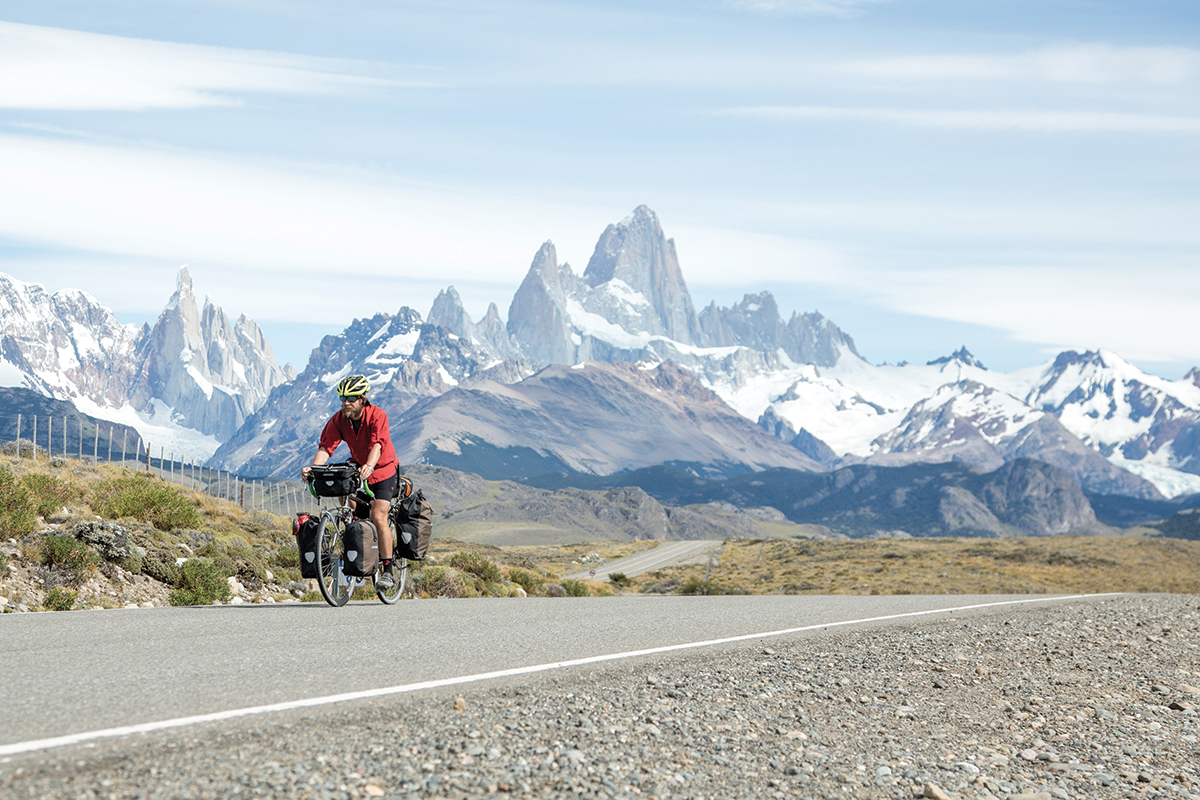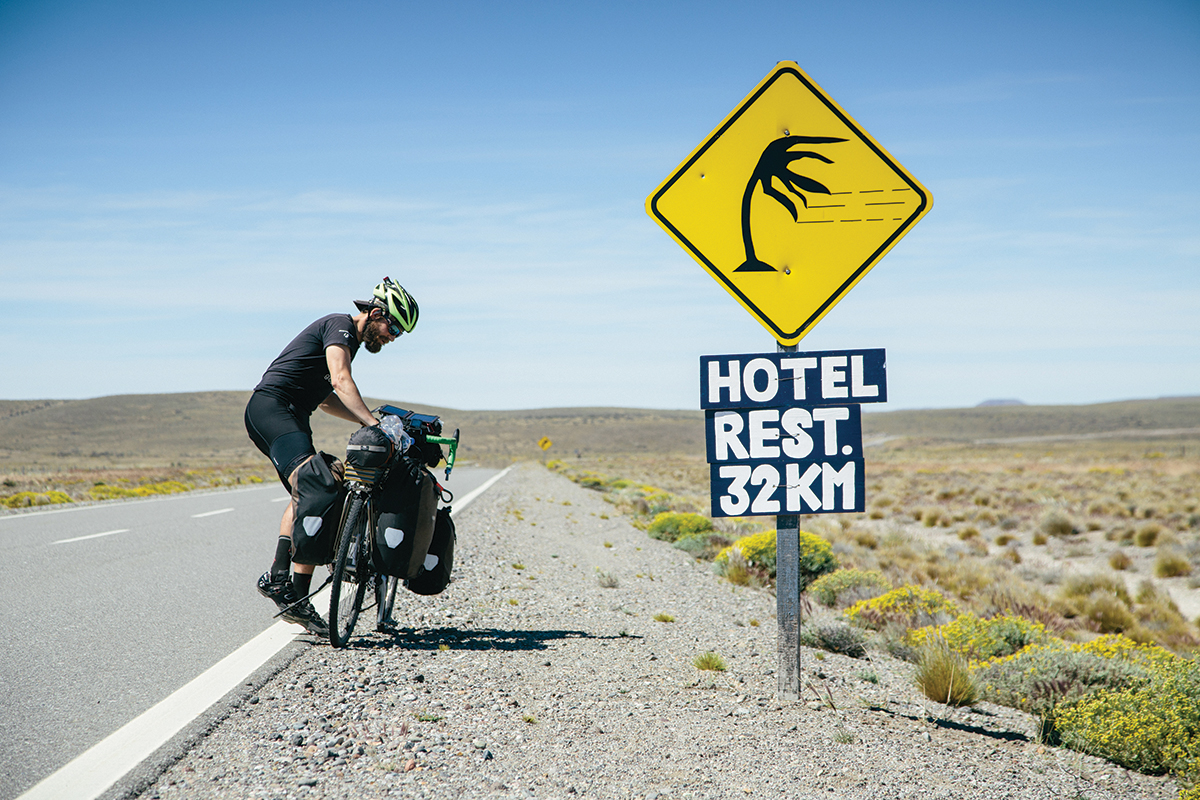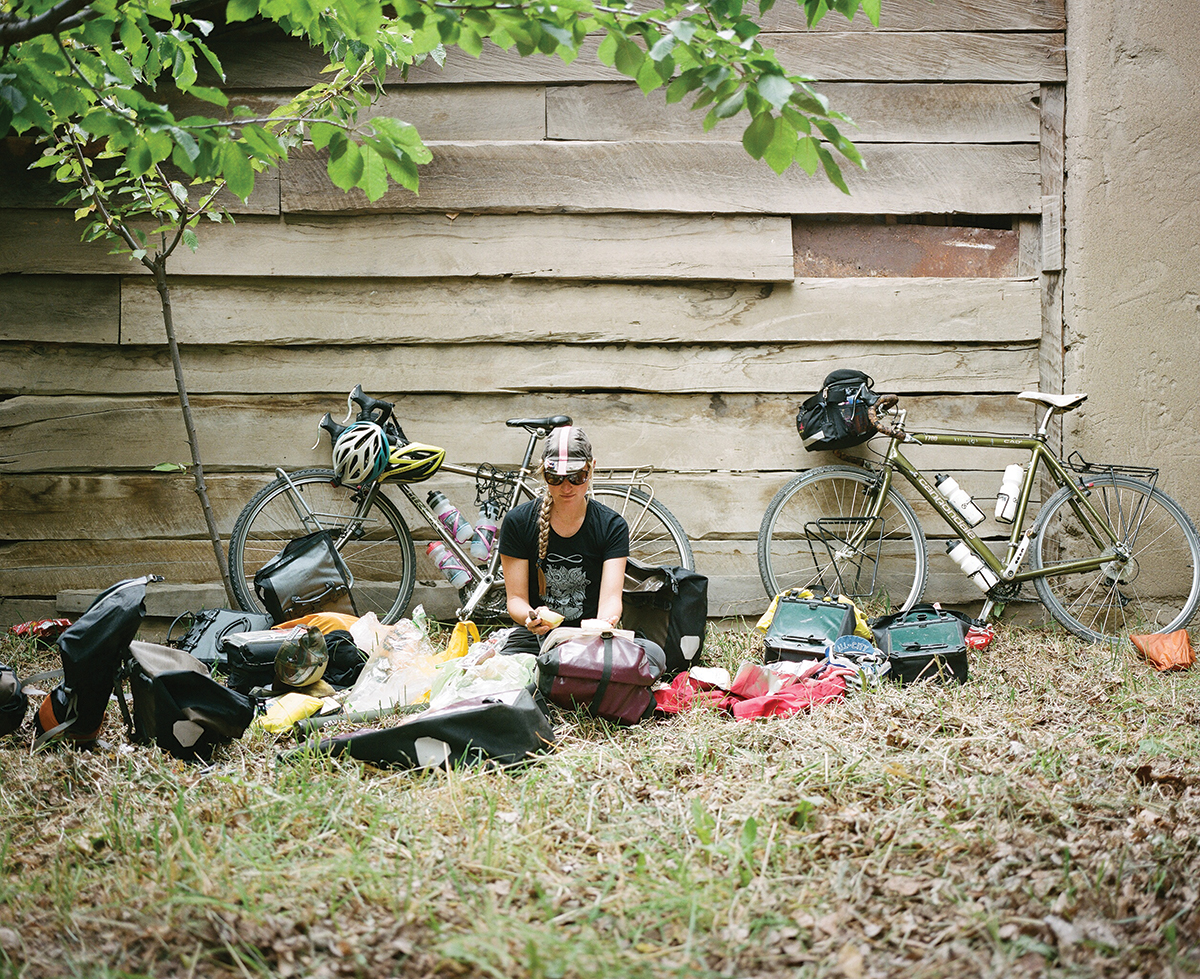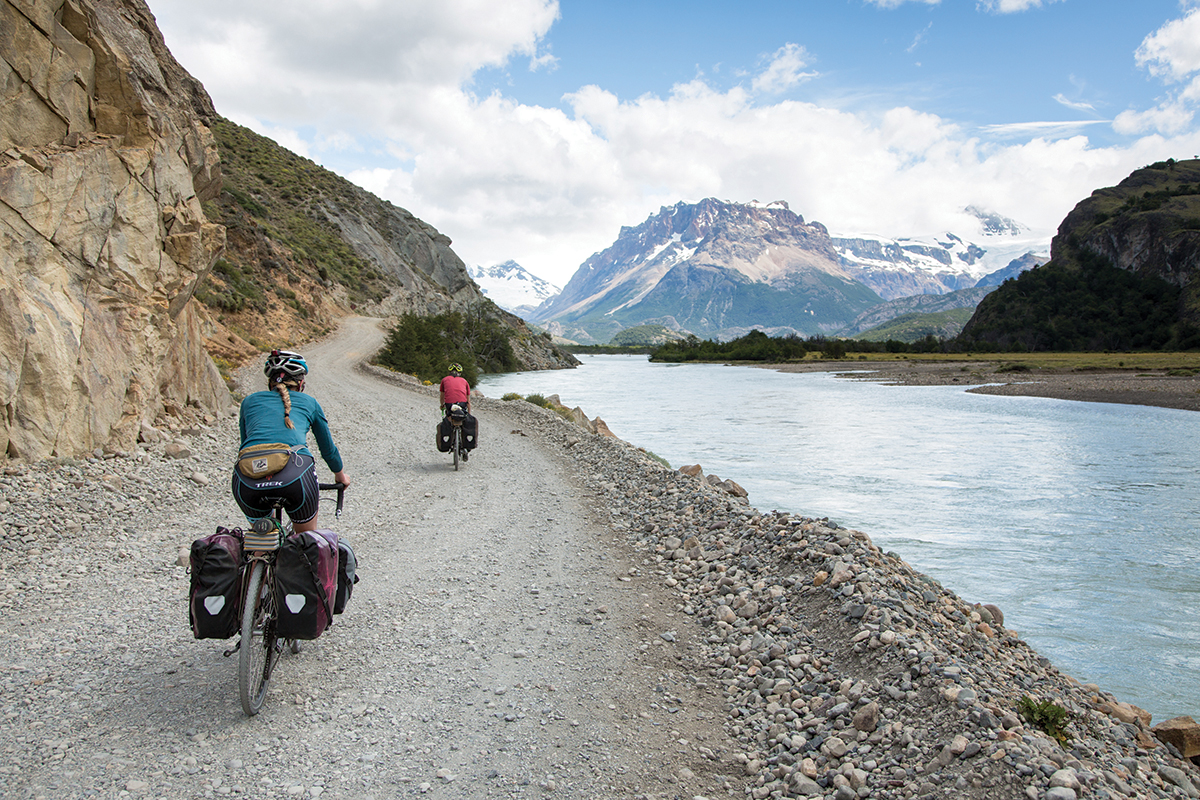Straight Roads and Wind
It was nearly noon, and the wind was starting to pick up. But with the temperature approaching 100 degrees, we were most concerned about the heat. Well, no. I guess it was actually the lack of services that we were the most concerned about in this windy, scorchingly hot, middle-of-nowhere place. The night before, we had camped on the side of Argentina’s iconic Ruta Nacional 40 — a stripped-down, southern version of Route 66. We were headed toward the small town of Bajo Caracoles, the final outpost with some basic but essential services before we’d encounter long stretches with no amenities and, at best, limited water. The bone-dry wind was wicking sweat off my neck as quickly as I could produce it. This was starting to feel like the Patagonia that I had always imagined.
I’ve been a member of Adventure Cycling now for over 25 years, the first 14 of which I also worked at the organization as a cartographer. Every so often during my time on staff, cofounder Greg Siple would saunter over to my desk and share a memory of Hemistour, the epic ride that he, his wife June, and Dan and Lys Burden were on from 1972-75 when they conceived the idea for Bikecentennial. Hemistour was the first bicycle tour to travel the length of the western hemisphere, starting in Anchorage, Alaska, and ending 18,272 miles and almost three years later in Ushuaia, Argentina.
Out of all of Greg’s stories from that trip, what really captured my attention was hearing about Patagonia, the beautiful and remote region spanning the southernmost reaches of South America. Patagonia encompasses parts of both Chile and Argentina, with the rugged Andes Mountains knitting the two countries together. With its glaciated valleys, terraced steppes, and towering summits, Patagonia seemed like a grand and imposing landscape.
Now I was finally here to experience it for myself, along with intrepid traveling companions Sonja Schmidt and Jason Harding. Battered by wind on the side of the highway, we quietly snacked and drank overheated water from our bottles, trying to figure out the best course of action for getting through the barren stretch ahead. I thought about Greg and June and the enormous scope of their adventure, and I couldn’t help but wonder, “How the hell did they do this?”

As we neared Bajo Caracoles, I kept glancing at my map. For us to make it to El Chaltén, the part that I was most looking forward to, we would be putting in hard, long days with only a day to explore the area. So I planned to get on the internet at our next stop and come up with an alternate strategy. Pulling into the “town,” though, I became a bit dubious about my objective. Baja Caracoles consisted of a few gravel roads lined with a campground that was closed, a hostel that was closed, and a small convenience store with showers and some rooms for rent. Outside of the store, we stopped a passerby and asked if there was wifi in town, which elicited a huge laugh. Dispirited, we resupplied with cold water and sandwiches and decided that we needed to get a ride.
It’s great to be in sync with traveling companions. One of the greatest parts about bike travel is being able to share the ups and downs with your fellow travelers. In this case, I was on the road with two of the best. In addition to being great people, Sonja and Jason are also professional guides for Trek Travel, the touring arm of Trek Bicycles. For seven to eight months a year they work hard leading high-end bike tours in Europe, and then during the off-season they strike out on their own adventures. When I got wind that they were headed south for a cycling and fly-fishing tour, I subtly invited myself along. Over food and wine one evening in Missoula, we pored over maps and made a plan, and just like that I was going to join them for a few weeks of touring in Patagonia. They were headed south in December and would be on the road for a month before I joined.
Now here we were in a convenience store in the middle of Argentina, putting our heads together for some problem solving. Through a mix of gestures and broken Spanish, we learned that a bus would probably stop at the store sometime around 10:00 or 11:00 pm. If it did stop, it wasn’t a sure thing that all three of us could get on with our bikes. But perhaps with a bit of cash, we could make it happen. It was noon, and we had nothing left to do but hang out and wait.
We took up seats outside and, as a backup plan, kept an eye out for vehicles traveling south that could potentially accommodate the three of us along with our bikes. Despite the fact that Bajo Caracoles is the only food and gas hub for miles in either direction, it took four hours to find our first lead. A tiny camper finally pulled up alongside the gas pump, and out climbed two clean-cut, bespectacled guys who looked as though they might speak English. Sonja and I elected Jason to go talk to them. He came back minutes later with a broad smile across his face. The men, both French, were up for it — if we could wrangle our bikes into their pint-sized camper. Luckily, Sonja and Jason are masters at packing bikes. Within minutes, everything was safely stowed, and the three of us were tucked into the backseat of the cab.

It was thrilling, rolling down the road at 60 mph, steadily clicking off the miles. The road was straight with no water and a lot of wind. It would have made for a tough and uninspiring ride. The more we drove, the happier we were in that backseat. Little did they know, but our new companions, Quentin and Julien, had just made a huge difference in the quality of our trip.
We found a riverside campsite in the next town and called it a night, and then we squeezed back into the rig the next morning. With these guys heading to El Chaltén, we figured we should just go the whole way. As we hit the road the next morning, what started as reasonably smooth pavement soon turned to gravel, which got progressively bumpier until the substrate became nothing more than an expanse of huge rocks. Eventually the roads improved before we turned west and headed toward El Chaltén.
From the road, it’s easy to spot the town’s location. El Chaltén sits at the base of Mount Fitz Roy, whose towering granite faces are visible from miles away. While many people might not recognize the mountain by name, millions have seen it — or at least a representation of it. Fitz Roy, and the peaks beside it, make up the logo for the Patagonia clothing company. While Cerro Chaltén, as the spire is also called, is a highly technical ascent attempted by only the most experienced climbers, the surrounding mountains are a huge draw for more casual adventurers. El Chaltén caters to these tourists and feels a bit like Jackson Hole, Wyoming, except with grittier accommodations and much slower internet.
After unloading our bikes in town, we said goodbye to our new French friends and thanked them profusely. Giddy from both our good fortune in catching a ride and the open invitation to visit our benefactors in Bordeaux, we wasted no time in exchanging some currency on the somewhat shady underground “blue dollar market,” and celebrating with food and drink.
Over a sizable pitcher of wine, we hatched a plan to find some fishable waters. There hadn’t been many opportunities to fish since I joined the trip, and Jason was itching to cast a line. Rumor had it that the glacier-fed Laguna del Desierto (Lake of the Desert) was a hidden gem just 50 kilometers up the road. The route was a straightforward out-and-back on a gravel road, with no way to get lost. How hard could it be? Answer: hard enough that we felt as though we were doing penance for having caught a ride the days before. With a combination of rocks, washboard, fully loaded bikes, and a fierce headwind, we might as well have been getting bucked around on a mechanical bull in some backwater Montana bar.
The winds of Patagonia are truly a force of nature. Air masses coming off the Pacific Ocean rise up over the Chilean side of the snow-covered Andes Mountains and cool before plunging back down the Argentinean slope. At ground level, the wind bursts can easily reach gale-force speeds. Much of the vegetation has adapted by hugging close to the ground — a smart move, considering how vulnerable we felt as we were exposed and pummeled by the relentless gusts.
About halfway to our destination, we came across two men traveling back toward El Chaltén. They didn’t speak English, but from their gesturing and the few Spanish words we could decipher, we surmised that they’d been on the road for a while and had been traveling down on the Carretera Austral. The Carretera Austral is a remote dirt road on the Chilean side of the Andes, but I was confused about how they had landed on this dead-end stretch of road. I gathered from their pantomiming that our bikes wouldn’t have made it on the Carretera Austral, that mountain bikes were definitely required. That said, one of the men seemed to be admiring our bicycles.

The closer we got to our destination, the easier the riding conditions became. Our campground was a welcome sight. Situated at the base of a glacier and dotted with shade trees, it offered a spectacular view of towering peaks. The scenery had some competition for our attention, though. As the campground filled up with a motley assortment of travelers, the people-watching was first-rate. And no one was more intriguing than the fellow who appeared — looking every bit like Fabio’s doppelgänger with his long, flowing hair — leading a horse with a petite woman astride it. He was followed by two other horses and riders, and once his gang had stabled their rides in the campground corral, they proceeded to set up camp. Were these people really doing a tour by horse?
As the night wore on, campers began to extinguish their campfires and retire for the evening. Eventually, ours was the only one still ablaze, prompting the horse guy and his lady friend to wander over and share the heat. As they warmed their hands, he also shared his story. A few weeks earlier, he had met the Swiss couple (the other two riders in his party) and learned that they were about to start a cross-Patagonia tour on horseback. It sounded like such a great adventure that he invited himself along despite the fact that he’d never before ridden a horse — he figured he’d work that out along the way. Sure enough he’d learned a lot already about the ins and outs of horse travel, and he admitted his good fortune in traveling with the Swiss riders, who had researched the route extensively prior to setting out.
That was all well and good, but it didn’t explain where the woman came from. When we asked, a smile spread across his face. It turned out that she had been hitchhiking on the very road we cycled out on. So he picked her up … on his horse. She didn’t speak or understand any English and just smiled throughout the whole story. We never learned where she was headed, but when they retired for the evening, they both crawled into his single-sized tent. Boy, just when you think you’re on a grand adventure, along comes someone who trumps you by picking up a cute hitchhiker on his spontaneous Patagonia horseback tour.
We spent the next day fishing, eating, and taking in the spectacular scenery around us. Well, Sonja and Jason were fishing, and I was chasing them around with a camera, trying not to fall in the chilly cerulean waters. I’m not a fly fisherman, but I’ve lived in Montana long enough to know that once the fishing bug bites you, there’s no turning back. Life is then consumed by trying to land the browns, bulls, and rainbows, and other concerns fall by the wayside. Here at Laguna del Desierto, Jason had a single-minded determination to land a big guy he’d spotted who just wasn’t falling for any of his tricks. While Sonja pulled in a succession of more diminutive fish farther down the bank, Jason kept working the same spot, muttering both to himself and the elusive prize. Well into the afternoon, I heard a blood-curdling scream and turned to see that Jason had finally hooked his target. After a short battle, he held the fish in his hands, grinned for a few photos, and then released the trout back into the stream to fight another day. Though we fished for a bit longer, the edge had been taken off. Jason was relaxed again, back to being a normal person. Victory was his.
As we strolled back to our camping spot, Jason, still high from the thrill of the catch, we noticed a couple walking their loaded touring bikes into the campground. Jeff and Roselind from Canada had been traveling for a number of months. Recently retired and their daughter just married, Roselind had gotten a tattoo and they hit the road. Sonja and Jason had run into them once or twice before, and the four of them spent some time catching up and swapping stories. It turned out that they too had come across the Carretera Austral route, and they told of dirt road adventures, trying to catch ferries, and paying someone to have his horse shuttle their panniers through a particularly tricky singletrack section. We learned that after crossing through the mountains, the route more or less dumps out into the campground where we were staying, thus solving the mystery of where all these travelers had materialized from. (Jeff and Roselind kept a great blog over the course of their trip; check out “Shift Happens” at crazyguyonabike.com.)
The road back toward El Chaltén the next morning was just as bumpy as it had been on the way out, but this time the wind was at our backs and we seemed to float over the washboard as we headed south. Just knowing that we were cruising back to familiar ground and already had lodging booked made the trip more relaxed and enjoyable. The tailwind continued to blow the following day as we departed El Chaltén and pedaled down the road. Our campsite that night was behind the “famous” Hotel de Campo La Leona, its notoriety coming from the fact that it was once the temporary hideout of Butch Cassidy and the Sundance Kid.
Pedaling around the corner into the hotel’s backyard campground, we found a tent already set up by a couple from California. Then we looked over and saw the Canadian couple staking out their tent. As we were pitching our own, up rolled the Argentinean men we had met on the dirt road. Everyone had run across each other at some point along the route, but this was the first time we were all in one place at the same time. It was a festive atmosphere, and the table was large enough that we were all able to dine together that evening. As almost everyone was approaching the end of their respective travels, there were many stories to share. We learned that they had all come down the Carretera Austral route; that really seemed like the way to go. The woman from California spoke Spanish and was able to converse with the Argentinean men and translate for us. They turned out to be brothers. One eventually confessed to have a major case of bike envy over our rides.
The next morning as we were packing up, our gang got a little bit larger when two brothers from France rolled up. They had recently started in the south and were headed all the way up to Alaska. They looked fresh and ready for adventure, which was a good thing as they were going to be on the road for a few years. I told them that if they were anywhere near Missoula, they had to stop by the Adventure Cycling office and say hello to Greg.

After breakfast, we all broke camp with groups heading out one by one for wherever the day would take them. One of the unique aspects of meeting up with other touring cyclists is that you might see them up the road in a matter of minutes — or you may never see them again. In this case, we never saw the Americans and the Canadians again, but we soon joined forces with the Argentinean brothers. We all lined up, the speed gradually increased, and in a few minutes we were sailing along at high speed in a legitimate pace-line. Eventually we backed off, and the lack of traffic allowed us to ride side by side. The road was absolutely gorgeous with smooth pavement, incredible views, long sightlines, and no cars to worry about. In other words, the conditions were as ideal as you could hope for.
Even though we didn’t speak the same language, one of the brothers started telling stories. He would do so with great gusto and enthusiastic hand gestures despite the fact that we had no idea what he was saying. When he finished a story, he’d laugh heartily and we would as well.
We rode together off and on throughout the day, and when it was time to find a camp spot, we banded together. Although it was not quite as idyllic as some of our other campsites, a vacant, weedy lot on the bank of the Rio Santa Cruz provided ample space for our tents, and the crumbling buildings made a nice windbreak. We set up tents underneath a row of trees, using a limb to sweep away the debris and broken glass. There was even an old pallet nearby to serve as our dinner table. As we ate around the pallet, the gregarious brother broke out “Argentinean schnapps” and began telling more stories. It tasted like gasoline-laced moonshine, but I swear the schnapps helped my Spanish comprehension skills that night. Or at least I remember learning one thing that evening — that the other, quieter brother worked for Nabisco making Oreo cookies in Buenos Aires. Man, I love Oreos.
The next morning, we heard them rustling around outside while we were still in our tents. I got up to take a quick portrait of them while they finished packing their bikes. The chatty brother looked a little rough, like he had enjoyed the schnapps a little too much the night before. He cast one more longing glance at my bike as they walked up to the road. We watched them pedal for a few hundred meters before they had to get off and push their loads up the first small hill. Yep, most definitely too much drink.
Looking back on the tour from my end point in the town of El Calafate, it was easy to see where the make-it or break-it part of the trip had been: the day we caught the ride with the Frenchmen. As often happens, the kindness of strangers makes for the most memorable moments. So, in an effort to pass it on (and also because I couldn’t find a bike box anywhere in that town), I left a gift of my own. I locked my bike to a post at the town’s hostel, took a photo, and put it on social media with a clue as to the combination for the lock, along with instructions to anyone who got it to post photos of their adventures with #endlessbiketour. As of this printing, I’ve seen no sign that it’s been taken. If anyone happens to run into the Argentinean brothers, tell them the combination is 1976.
Patagonia Nuts & Bolts
Best time to travel
The best times to travel in the southern parts of Patagonia on a bike are December to late February. This allows the best weather window of the year, but the winds can still be fierce at times.
General Logistics
It’s good to know a little bit of Spanish, especially in the rural areas. But in the more touristy towns, English is spoken in varying degrees. Empanadas make for great bike touring food and are available everywhere. Traffic is minimal even on the main roads. There are two routes you can travel. We rode traditional road touring bikes and stuck to the paved roads east of the Andes in Argentina. It can be dry, with services becoming more scarce the farther south you travel. On the west side of the Andes runs the Carretera Austral. For this route, you need a sturdy mountain bike and the capacity to carry a lot of gear and food. It’s mostly dirt, with the occasional ferry crossing and hike-a-bike sections.
What to pack
Plenty of spare parts. Even on mostly paved routes, you will inevitably end up on a bumpy dirt road at times. After a few miles of being bounced around, screws and bolts tend to work themselves loose, especially with racks and panniers. Also, pack coffee. While they grow coffee in South America, they seem to export all of the good stuff. And finally, bring patience — the wifi is painfully slow.
Resources
patagonia-argentina.com/i/regiones.php
cyclingpatagonia.wordpress.com
This story originally appeared in the April 2016 issue of Adventure Cyclist magazine.

